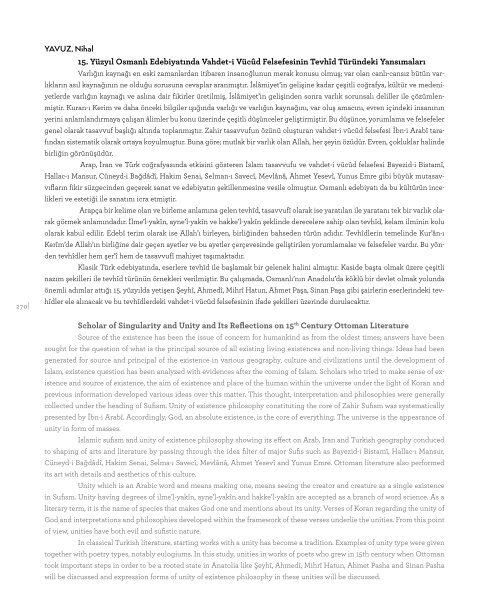14 - 17
MdZ0re
MdZ0re
You also want an ePaper? Increase the reach of your titles
YUMPU automatically turns print PDFs into web optimized ePapers that Google loves.
270|<br />
YAVUZ, Nihal<br />
15. Yüzyıl Osmanlı Edebiyatında Vahdet-i Vücûd Felsefesinin Tevhîd Türündeki Yansımaları<br />
Varlığın kaynağı en eski zamanlardan itibaren insanoğlunun merak konusu olmuş; var olan canlı-cansız bütün varlıkların<br />
asıl kaynağının ne olduğu sorusuna cevaplar aranmıştır. İslâmiyet’in gelişine kadar çeşitli coğrafya, kültür ve medeniyetlerde<br />
varlığın kaynağı ve aslına dair fikirler üretilmiş, İslâmiyet’in gelişinden sonra varlık sorunsalı deliller ile çözümlenmiştir.<br />
Kuran-ı Kerim ve daha önceki bilgiler ışığında varlığı ve varlığın kaynağını, var oluş amacını, evren içindeki insanının<br />
yerini anlamlandırmaya çalışan âlimler bu konu üzerinde çeşitli düşünceler geliştirmiştir. Bu düşünce, yorumlama ve felsefeler<br />
genel olarak tasavvuf başlığı altında toplanmıştır. Zahir tasavvufun özünü oluşturan vahdet-i vücûd felsefesi İbn-i Arabî tarafından<br />
sistematik olarak ortaya koyulmuştur. Buna göre; mutlak bir varlık olan Allah, her şeyin özüdür. Evren, çokluklar halinde<br />
birliğin görünüşüdür.<br />
Arap, İran ve Türk coğrafyasında etkisini gösteren İslam tasavvufu ve vahdet-i vücûd felsefesi Bayezid-i Bistamî,<br />
Hallac-ı Mansur, Cüneyd-i Bağdâdî, Hakim Senai, Selman-ı Savecî, Mevlânâ, Ahmet Yesevî, Yunus Emre gibi büyük mutasavvıfların<br />
fikir süzgecinden geçerek sanat ve edebiyatın şekillenmesine vesile olmuştur. Osmanlı edebiyatı da bu kültürün incelikleri<br />
ve estetiği ile sanatını icra etmiştir.<br />
Arapça bir kelime olan ve birleme anlamına gelen tevhîd, tasavvufî olarak ise yaratılan ile yaratanı tek bir varlık olarak<br />
görmek anlamındadır. İlme’l-yakîn, ayne’l-yakîn ve hakke’l-yakîn şeklinde derecelere sahip olan tevhîd, kelam ilminin kolu<br />
olarak kabul edilir. Edebî terim olarak ise Allah’ı birleyen, birliğinden bahseden türün adıdır. Tevhîdlerin temelinde Kur’ân-ı<br />
Kerîm’de Allah’ın birliğine dair geçen ayetler ve bu ayetler çerçevesinde geliştirilen yorumlamalar ve felsefeler vardır. Bu yönden<br />
tevhîdler hem şer’î hem de tasavvufî mahiyet taşımaktadır.<br />
Klasik Türk edebiyatında, eserlere tevhîd ile başlamak bir gelenek halini almıştır. Kaside başta olmak üzere çeşitli<br />
nazım şekilleri ile tevhîd türünün örnekleri verilmiştir. Bu çalışmada, Osmanlı’nın Anadolu’da köklü bir devlet olmak yolunda<br />
önemli adımlar attığı 15. yüzyılda yetişen Şeyhî, Ahmedî, Mihrî Hatun, Ahmet Paşa, Sinan Paşa gibi şairlerin eserlerindeki tevhîdler<br />
ele alınacak ve bu tevhîdlerdeki vahdet-i vücûd felsefesinin ifade şekilleri üzerinde durulacaktır.<br />
Scholar of Singularity and Unity and Its Reflections on 15 th Century Ottoman Literature<br />
Source of the existence has been the issue of concern for humankind as from the oldest times; answers have been<br />
sought for the question of what is the principal source of all existing living existences and non-living things. Ideas had been<br />
generated for source and principal of the existence in various geography, culture and civilizations until the development of<br />
Islam, existence question has been analyzed with evidences after the coming of Islam. Scholars who tried to make sense of existence<br />
and source of existence, the aim of existence and place of the human within the universe under the light of Koran and<br />
previous information developed various ideas over this matter. This thought, interpretation and philosophies were generally<br />
collected under the heading of Sufism. Unity of existence philosophy constituting the core of Zahir Sufism was systematically<br />
presented by İbn-i Arabî. Accordingly, God, an absolute existence, is the core of everything. The universe is the appearance of<br />
unity in form of masses.<br />
Islamic sufism and unity of existence philosophy showing its effect on Arab, Iran and Turkish geography conduced<br />
to shaping of arts and literature by passing through the idea filter of major Sufis such as Bayezid-i Bistamî, Hallac-ı Mansur,<br />
Cüneyd-i Bağdâdî, Hakim Senai, Selma-ı Savecî, Mevlânâ, Ahmet Yesevî and Yunus Emre. Ottoman literature also performed<br />
its art with details and aesthetics of this culture.<br />
Unity which is an Arabic word and means making one, means seeing the creator and creature as a single existence<br />
in Sufism. Unity having degrees of ilme’l-yakîn, ayne’l-yakîn and hakke’l-yakîn are accepted as a branch of word science. As a<br />
literary term, it is the name of species that makes God one and mentions about its unity. Verses of Koran regarding the unity of<br />
God and interpretations and philosophies developed within the framework of these verses underlie the unities. From this point<br />
of view, unities have both evil and sufistic nature.<br />
In classical Turkish literature, starting works with a unity has become a tradition. Examples of unity type were given<br />
together with poetry types, notably eulogiums. In this study, unities in works of poets who grew in 15th century when Ottoman<br />
took important steps in order to be a rooted state in Anatolia like Şeyhî, Ahmedî, Mihrî Hatun, Ahmet Pasha and Sinan Pasha<br />
will be discussed and expression forms of unity of existence philosophy in these unities will be discussed.


